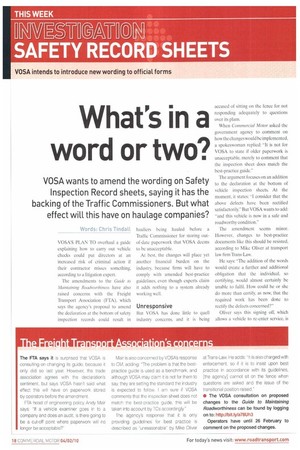What's in a word or two?
Page 18

Page 19

If you've noticed an error in this article please click here to report it so we can fix it.
VOSA wants to amend the wording on Safety Inspection Record sheets, saying it has the backing of the Traffic Commissioners. But what effect will, this have on haulage companies?
Words: Chris Tindall VOSA'S PLAN TO overhaul a guide explaining how to carry out vehicle checks could put directors at an increased risk of criminal action if their contractor misses something, according to a litigation expert.
The amendments to the Guide to Maintaining Roadworthiness have also raised concerns with the Freight Transport Association (FTA). which says the agency's proposal to amend the declaration at the bottom of safety inspection records could result in hauliers being hauled before a Traffic Commissioner for storing outof-date paperwork that VOSA deems to be unacceptable.
At best, the changes will place yet another financial burden on the industry, because firms will have to comply with amended best-practice guidelines, even though experts claim it adds nothing to a system already working well.
Unresponsive But VOSA has done little to quell industry concerns, and it is being accused of sitting on the fence for not responding adequately to questions over its plans.
When Commercial Motor asked the government agency to comment on how the changes would be implemented, a spokeswoman replied: "It is not for VOSA to state if older paperwork is unacceptable, merely to comment that the inspection sheet does match the best-practice guide."
The argument focuses on an addition to the declaration at the bottom of vehicle inspection sheets. At the moment, it states: "I consider that the above defects have been rectified satisfactorily." But VOSA wants to add: "and this vehicle is now in a safe and roadworthy condition."
The amendment seems minor. However, changes to best-practice documents like this should be resisted, according to Mike Oliver at transport law firm Trans-Law.
He says: "The addition of the words would create a further and additional obligation that the individual, so certifying, would almost certainly be unable to fulfil. How could he or she do more than certify, as now, that the required work has been done to rectify the defects concerned?"
Oliver says this signing off, which allows a vehicle to re-enter service, is normally done by a manager or other designated individual with little or no mechanical knowledge, making it very difficult for them to state that a vehicle is defect-free and in a roadworthy condition.
Operators and nominated transport managers already have an obligation to ensure vehicles arc safe and that the existing regime establishes a document trail that can verify proper compliance.
Oliver adds: 'if the whole procedure is designed to ensure vehicles are safe. and roadworthy, how would such wording further that end?" More alarming is a situation in which defects are missed. Oliver says: The 'signing-off' is a cross-check to ensure work required has been done.
He adds: "The signing off may. therefore, be done by someone outside the workshop or, after a vehicle has been returned by external contractors, by someone who has no way of knowing an more than they arc told about the vehicle's condition:'
Legal action
Oliver goes on to say:"They would then be at serious risk of civil or criminal action — as may the operator, or directors — if they certified the vehicle was safe and roadworthy when contractors had missed or overlooked something, or for some other reason beyond their knowledge it was not."
Peter Woodhouse, transport lawyer and partner at Stone King Sewell Solicitors, believes it would only take a scenario in which an unhelpful VOSA officer was combined with an unsympathetic IC, for operators to fall foul of out-of-date documentation.
He explains operators should already ensure that, following maintenance inspections, the vehicle is in the right condition and that the form is signed by someone who possesses the necessary knowledge.
But Woodhouse adds: "Given that VOSA cites the agreement of industry to support the wording of the existing guide, it would be unwise in relation to the new guide simply to dismiss industry concerns."
A TCs' welcome VOSA reveals that the proposed amendment "ensures that operators make the statement that vehicles in use are compliant with the 0-licence declaration. In addition, the suggestion has been welcomed and encouraged by TC.s."
Commercial Motor approached the Senior TC's office and asked what concerns exist for it to encourage this specific amendment. We also asked if the Senior TC was able to allay the industry's fears over out-of-date paperwork and to comment on concerns over criminality,
A spokesman for Senior TC Philip Brown says: "The rewording in the consultation re-emphasises the importance of an operator's commitment to running vehicles [that are] in a fit and serviceable condition."




































































































































